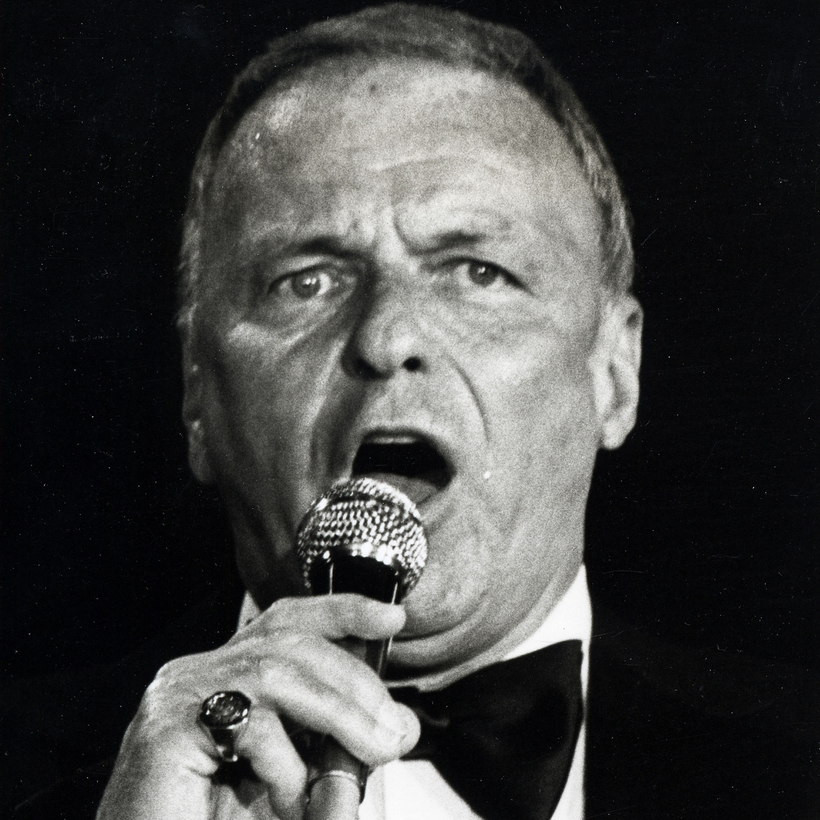I saw Frank Sinatra sing live but once, and not, alas, when he was in his prime. It was 1992, at the Desert Inn, in Las Vegas, when he was 76—two years before he quit performing regularly, six years before his death. His voice was froggy, his toupee silly. Even with a teleprompter in front of him—there was no effort made to hide it—he forgot lyrics to songs he’d been singing for decades. Perhaps in frustration, he took repeated potshots at his son, Frank Sinatra Jr., who was conducting the band, pointing out that he had been a nepotism hire. (We figured as much.)
All in all, it was a sour, dispiriting spectacle, and yet … the audience, most of whom looked to be more or less the same vintage as Sinatra, couldn’t have cared less. The connection between singer and fans was electric, even if the music wasn’t. In their smiles and applause as they recognized the opening notes of each new song, you sensed what Sinatra had meant to people who (unlike me, a latecomer) grew up with him, romanced to him, got old with him. They loved him regardless—maybe even that much more because of his obvious flaws and vulnerabilities.

Sinatra and Me: In the Wee Small Hours has a similar vibe. It’s an unblinking yet affectionate portrait of the singer in the October, November, and December of his years, and should appeal to diehards and rubberneckers alike. The author is Tony Oppedisano, right-hand man and then some to Sinatra during his last quarter-century.
Frank’s Guy
A true intimate, Tony O, as he was known in Sinatra’s circles, first met the man in 1972. At the time, Oppedisano was a 21-year-old singer and jazz guitarist with a modest career playing Manhattan clubs. Naturally, he worshipped Sinatra. The introduction was made by a mutual friend, Jilly Rizzo, the bar owner who served Sinatra as a combination body man, road manager, best friend, four-A.M. confidant, and fixer—“Frank’s guy,” in the vernacular.
Oppedisano clicked with the Chairman and soon found himself on call as Rizzo’s backstop—Frank’s guy’s guy. “Frank’s world wasn’t always a picnic,” Oppedisano writes (with the assistance of Mary Jane Ross). But what choice did he and Jilly have when the Chairman called? Sinatra “had a force that sucked in everyone and everything around him.”
I’m still waiting for someone to explain the physics behind how that worked, how Sinatra could set Vegas or Palm Springs atremble simply by beginning his descent toward the airport. Anyway, following Rizzo’s death, in 1992, Oppedisano enlisted in the Night’s Watch full-time. Since he was a quarter-century younger than his boss, the role of surrogate son was added to the job description. In fact, he was the one holding Sinatra’s hand and comforting him when the singer died of a heart attack, in 1998; Sinatra’s fourth wife, Barbara (the former Mrs. Zeppo Marx), had snubbed his actual children by not alerting them to the fact that their father was on his deathbed.

Aside from recording the singer’s last words—“I’m losing”; how honest, simple, and direct after decades of “My Way”—what else did Oppedisano’s job entail? Here is his description of putting Sinatra to bed at dawn, the boss’s usual turn-in time, after a long, boozy night:
I helped him get undressed, then brought the baby-blue, custom pajamas he liked. By that time, he was completely naked, and as I knelt on the floor to put the first pants leg on, I noted he was staring down at his manhood.
He mumbled, “Madon’! If you could only tell my friend where you’ve been….”
I concentrated on maneuvering the pajama leg and said, “You know, Frank, it’s seven-thirty in the morning and I’m really tired. Perhaps it would be a shorter list if he told me where he hasn’t been.”
Frank chuckled, and so did I.

As this wistful, “Very Good Year”-style tribute to his own penis suggests, Oppedisano’s Frank is a more reflective, more isolated, more henpecked Sinatra than we’re used to, what with his powers ebbing, his wife and children feuding, his friends and cronies dying off. It’s a portrait that works as a counterpart and de facto sequel to the indispensable Mr. S: My Life with Frank Sinatra, the 2003 book written by the singer’s former valet, George Jacobs (with William Stadiem).
Mr. S covers Sinatra’s glory years in the 1950s and 1960s, up until 1968, when Jacobs was fired amid his boss’s last gasps of cultural relevance. The two books are a bit yin and yang. Mr. S has the hookers, the Kennedys, and the Rat Pack at the Sands, but Sinatra and Me has, well, Frank’s last dinner with Dean Martin, a few months before Dino’s Christmas Day death, in 1995.
What did they talk about? The good old days, sure, but also hearing aids.
Bruce Handy is a New York–based journalist and the author of Wild Things: The Joy of Reading Children’s Literature as an Adult


